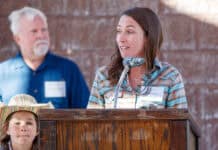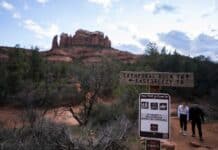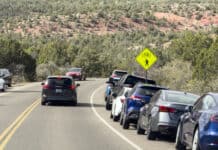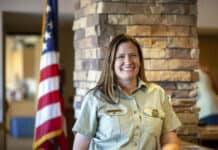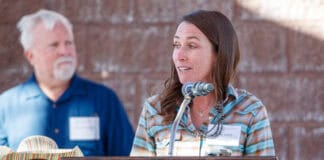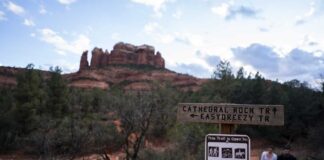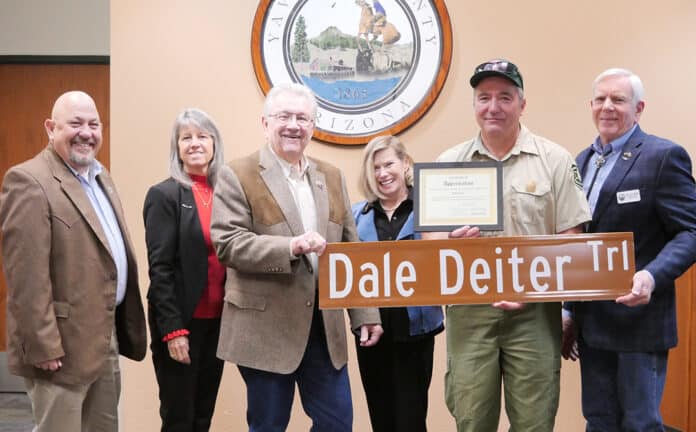
The Yavapai County Board of Supervisors recognized outgoing Supervisor of the Prescott National Forest Dale Deiter for his work during its Wednesday, Dec. 6 meeting in Prescott.
Deiter’s last day will be Saturday, Dec. 30, and his successor Sarah Clawson will take over the next day. Clawson currently serves as the district ranger for the Bradshaw and Chino Valley Ranger Districts.
“Dale Deiter came to the Prescott National Forest in January of 2018. He started his career with the Forest Service in May of 1984 as a temp, then received [a] permanent position in August of 1989,” Yavapai County District 2 Supervisor James Gregory said at the meeting. “He has a total of 35 years and 4 months of cumulative service. Thank you, Dale, you will be greatly missed.”
“[Deiter] is a Cherokee Nation citizen … he came to Prescott National Forest as a supervisor, with more than 30 years in public service,” Yavapai County District 4 Supervisor Craig Brown said at the meeting. “[He] grew up in Arizona, followed his father’s footsteps, who served as a district ranger in Arizona and New Mexico. Dale began his career in 1983 in the U.S. Forest Service as a volunteer, then a wildland firefighter for the Gila-National Forest in New Mexico, and in Bridger-Teton National Forest in Jackson, Wyoming. He earned his bachelor’s degree and a master’s degree in forestry from Northern Arizona University in Flagstaff.”
Deiter confirmed that he will remain at his home in Prescott Valley and will be volunteering with trail crews post-retirement. Working with volunteer trail crews is also among his favorite memories of leading the Prescott National Forest, along with projects that bolster tribal sovereignty such as the Yavapai Land Exchange.
“The thing you find about the people that work in any of the government, state, local or federal,” Deiter said, “they’re about contributing something that’s bigger than themselves and with a love of service and just being able to be out [and] continue to work. Touching people like that is rewarding for me.”
Deiter cited the implementation of Great American Outdoors Act projects such as the stabilization of the Sycamore Canyon Cliff Dwelling and conducting inventories of archaeological sites and wildlife within the Prescott National Forest as being his proudest achievements as supervisor.
“I’m certainly proud of the work we’ve been doing to reduce community risk under the Wildland Fire Crisis Strategy,” he said. “Then the work we’ve done with [the] Upper Verde River Suitability Study, as well as the Yavapai Ranch, Land and Water Conservation Fund … we’ve learned a lot more about the forest in terms of what’s out there, and what we need to do to sustain it.”
The challenges of the job have become more complex over the course of Deiter’s career, Brown noted.
“In 2018, Dale was quoted as saying, ‘Even in my career, fire season has gotten longer, and fires have gotten bigger, and we are seeing its impact even in terms as snowpack and spring flow and that then presents a lot of challenges in long-term sustaining management of national forest. There are a lot of challenges to deal with [on the Prescott National Forest] and it’s a neat forest with great people, and so I will finish out my career there.’”
“Part of it is I grew up in the Forest Service, my dad was on [a] type one fire team and so I was always tracking when he was away from home the type and size of fires that he was dealing with,” Deiter explained. “Over the course of his career, I watched them get bigger and more complex [since the early 1980s] … There wasn’t such a thing as a 500,000 acre fire back when my dad was in the service; 50,000 acres was a big and complex fire. Fires are an order of magnitude larger now.”
While the challenges of managing fire in the West have increased, Deiter noted that he sees a high degree of cooperation between the various agencies that work to mitigate wildfire risk in Yavapai County.
Reduced base flow to the Verde River is also predicted to interfere with the river’s usefulness for sport fishing because of increased water temperatures and a lower dissolved oxygen content, according to a Citizens’ Water Advocacy Group policy paper.
Deiter attributed the decreased base flow to “increased demands from people as well as the changing climate. That’s one thing I’ve seen a lot in my career. When I was a ranger in Wyoming, we started having [the] pine beetle get into whitebark pine, which is a high-elevation pine. Historically, when the beetle would pupate, it wouldn’t have enough time to get through and complete pupation during the winter. But because of the warmer winters it was actually able to complete its life cycle before it got too cold. That’s one example of many, where you can see fingerprints of climate change touching ecosystems we’ve been working with. Also, just the fact people talk about how now we kind of have a fire year rather than a fire season nationally and just the size and severity of fires getting bigger. All those things are things that have been obvious over the course of my career.”
Dieter said he doesn’t think that his successor needs much advice and that she is “ready to hit the ground running.”
“The advice I would have for anyone in this job, and it was the best advice I received at the beginning of my career as a line officer, it was three things. One is listen, two is listen and three is listen,” Dieter said.
Clawson joined the U.S Forest Service in 2010 as a program specialist for the Pacific Southwest Region’s Fire and Aviation Management program, where she spearheaded the creation of a Fuels Management Strategy for California’s 18 national forests. She has been a member of the National Fire Leadership Council’s National Line Officer Team since 2015, and she is currently a cadre member on multiple national training projects centered on risk management leadership abilities.
“What I love about the Prescott National Forest and the communities is the amazing reputation it had before I even came here,” Clawson said. “I knew it was a place that had a wide range of ecosystems. Our motto is ‘From the desert to the pines.’ We have a diverse set of ecosystems and wildlife. The Prescott National Forest is known for the amazing relationships we have with partners. People would rave about the communities in general and working for Prescott and living in the community they all turned out to be true in spades.”


